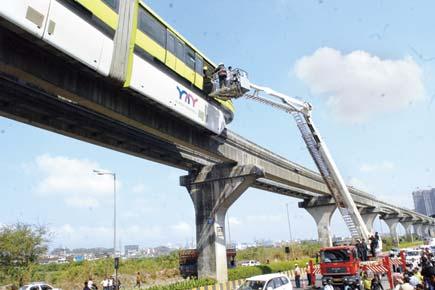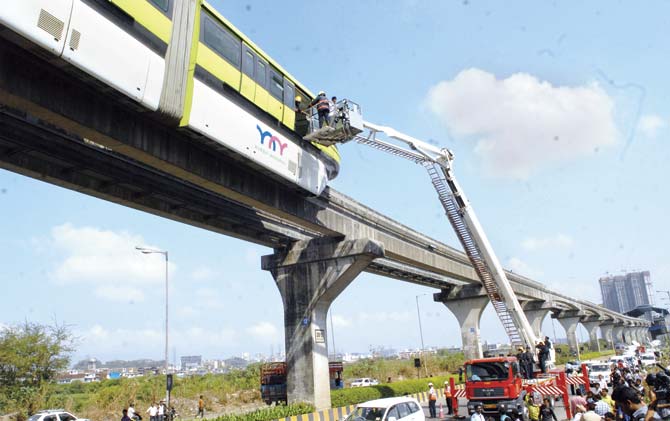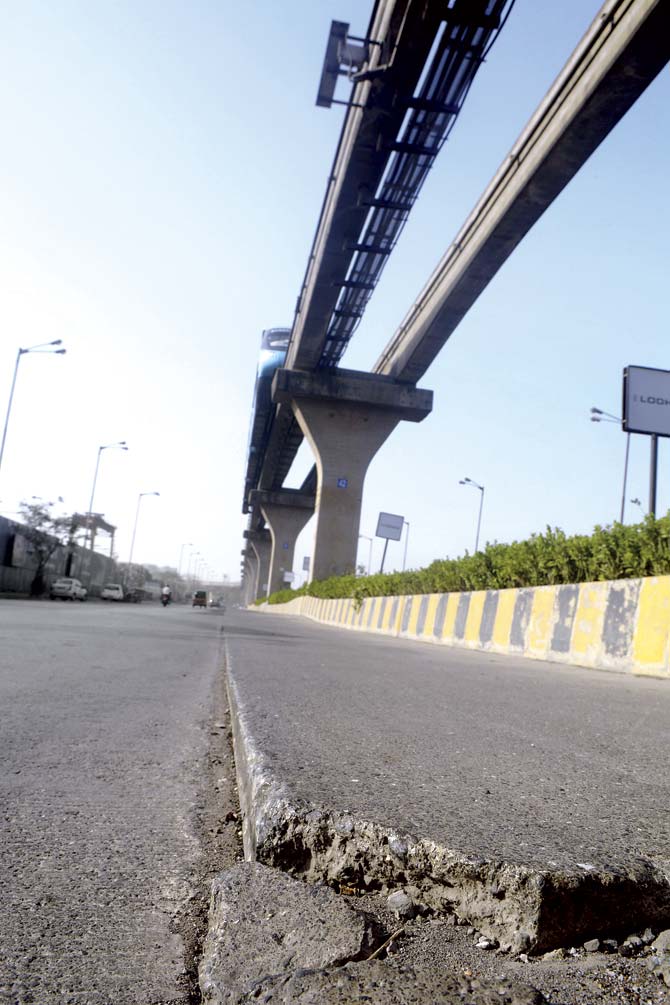CAG questions durability of Monorail, pulls up government for serious lapses; auditor says MMRDA looked on even as construction agency flouted contract norms

The Comptroller and Auditor General of India (CAG) has slammed the Mumbai Metropolitan Region Development Authority (MMRDA) for committing serious lapses in construction of the Mumbai Monorail, which it said, may hamper durability of the project.

Around 11 passengers were evacuated by the fire brigade after the Monorail stopped near Bhakti Park on March 15, 2015. File pic
ADVERTISEMENT
The CAG has observed that all civil structures were to be designed for a life of 120 years, but the construction agency ignored the norms and MMRDA did not take any action against it for violating contract conditions. The report was tabled in the state legislature yesterday, the last day of the Budget Session.

Cracks have appeared around the Monorail piers
The CAG, in its report for the year 2015, has pointed out irregularities in appointing consultants, tendering process, design, operations, maintenance, and most importantly faulty electrification (traction) work, which had stalled operations last month, following which the passengers had to be evacuated.
Sources said the report has revealed the reasons for the power failure, which is being probed by the principal secretary (urban development) following a directive from Chief Minister Devendra Fadnavis. The running and maintenance of the country’s first such project has been dogged by frequent disruptions, bad management and poor ridership since it started operating 13 months ago.
The report says the stipulated date of completion of Monorail’s Phase I (between Wadala and Chembur) and II (between Wadala and Jacob Circle) was November 2010 and May 2011, respectively. While Phase I was completed after a delay of 38 months in December 2013, Phase II was extended up to September 2015, thus registering a delay of 52 months. Phase I started in February 2014.
The report has observed that on account of failure of Larsen & Toubro and Scomi Engineering of Malaysia (LTSE) to achieve a number of key milestones by stipulated dates, the liquidated damages of Rs 153.15 crore up to August 2011 had not been levied on LTSE till November 2014.
Design issues
The audit compared the various standards and specifications for civil works mentioned in the contract documents/technical proposal of LTSE, with the design documents approved by MMRDA and PMC. The comparison revealed many inadequacies. Subsequently, the design was corrected.
The construction agency had joined reinforcement bars at 11 beams in Phase I of the project between Wadala and Bhakti Park with 100 per cent screwed couplers, creating a possibility of the joints becoming very stiff, thereby reducing the ductility required for seismic Zone 4. No penalty was levied on LTSE. Expansion joints of the guideway were designed in violation of contract specifications.
The alignment of the Freeway was not considered while deciding the alignment of the Monorail. Nine piles valued at R4.89 crore eventually proved to be wasteful. The realignment in this stretch delayed the works by 535 days.
Durability in question
The contract provided for application of protective coating on the concrete structures for protection against extreme weather conditions. The situation in Mumbai is even worse owing to high penetration of carbon dioxide due to pollution, resulting in corrosion of reinforcement bars.
The audit observed that protective coating (anti-carbonation paint) was not done by LTSE (November 2014), though Phase I had already been commissioned from February 2014. MMRDA stated that, initially, payment was withheld for non-execution of anti-carbonation paint by LTSE but it was released later after LTSE assured that they would apply anti-carbonation paint. MMRDA added that protective coating on the concrete surfaces would be taken up shortly.
Till March 2011, LTSE had been carrying out the work of anti-corrosive treatment (ACT) to reinforcement bars without cleaning the steel by sand blasting, as provided for in the contract. Consequently, MMRDA deducted Rs 6.42 crore from the running account bills of LTSE paid till May 2011. However, 1,046 piles, 286 pier caps and 271 piers have already been constructed without proper treatment and the situation is irretrievable now.
The guideway structure of the Monorail was to be designed as a pre-cast, pre-stressed continuous structure, but the construction agency continued to violate these norms. The reply by the director (Monorail) was not convincing, says the report.
Violation of contract conditions
The LTSE mentioned the use of concrete grade M-40 for piles and piles caps in its technical package. The consultant had approved (in November 2009) the design criteria for guideway structure with concrete grade M-35. A total of 2,580 piles and 637 pile caps had already been constructed by LTSE using M-35 grade concrete as per the progress report of April 2014. MMRDA told the auditors that the savings generated from this deviation would be recovered from LTSE.
Inadequacies in electric traction system
Though the work contract stipulated that the Monorail system, including the traction system, be designed for headway (gap between two services) of three minutes, the system was designed for headway of 4.5 minutes. Thus, the traction system may not withstand the loads when services are run for headway of three minutes.
MMRDA has accepted the facts and stated that the traction system can be upgraded in the future to cater to the requirement of a three-minute headway.
Higher trip rates
The report says that the action of MMRDA to grant higher trip rates for the first year of operations by R934 was irregular and rendered an undue financial benefit of R1.58 crore to LTSE because of the project implementation schedule.
The audit noted that 13 train sets proposed by LTSE were expected to run an estimated 5,148 km every day, and the resultant O&M cost worked out to be Rs258, Rs 315 and Rs 381 per train km per day for the first three years respectively. The O&M cost of the Delhi Metro (2007-08) was Rs 152 per train km per day.
The audit further observed that based on the proposal (June 2012 and March 2013) of LTSE, MMRDA agreed (October 2013) to increase the per trip cost of the first year from Rs 2,564 to Rs 3,498 on the premise that there was likely to be a gap of six months between starting of commercial operations under Phases I and II.
No escalator tenders
The contract for the Monorail project did not include provision for escalators and was to be taken up separately. The audit observed that based on three quotations procured by LTSE in August 2012, MMRDA accorded (September 2012) an administrative approval for procurement of 66 escalators for 17 stations.
A total cost of Rs 140.04 crore was incurred without competitive bidding. MMRDA justified the direct procurement stating that tendering for escalators would have led to the possibility of induction of a new agency, apart from LTSE, in the Monorail project premises while the work at stations was in progress.
CAG has rejected MMRDA’s reply and expected open tendering, which would have also ensured probity and transparency in procurement.
 Subscribe today by clicking the link and stay updated with the latest news!" Click here!
Subscribe today by clicking the link and stay updated with the latest news!" Click here!







